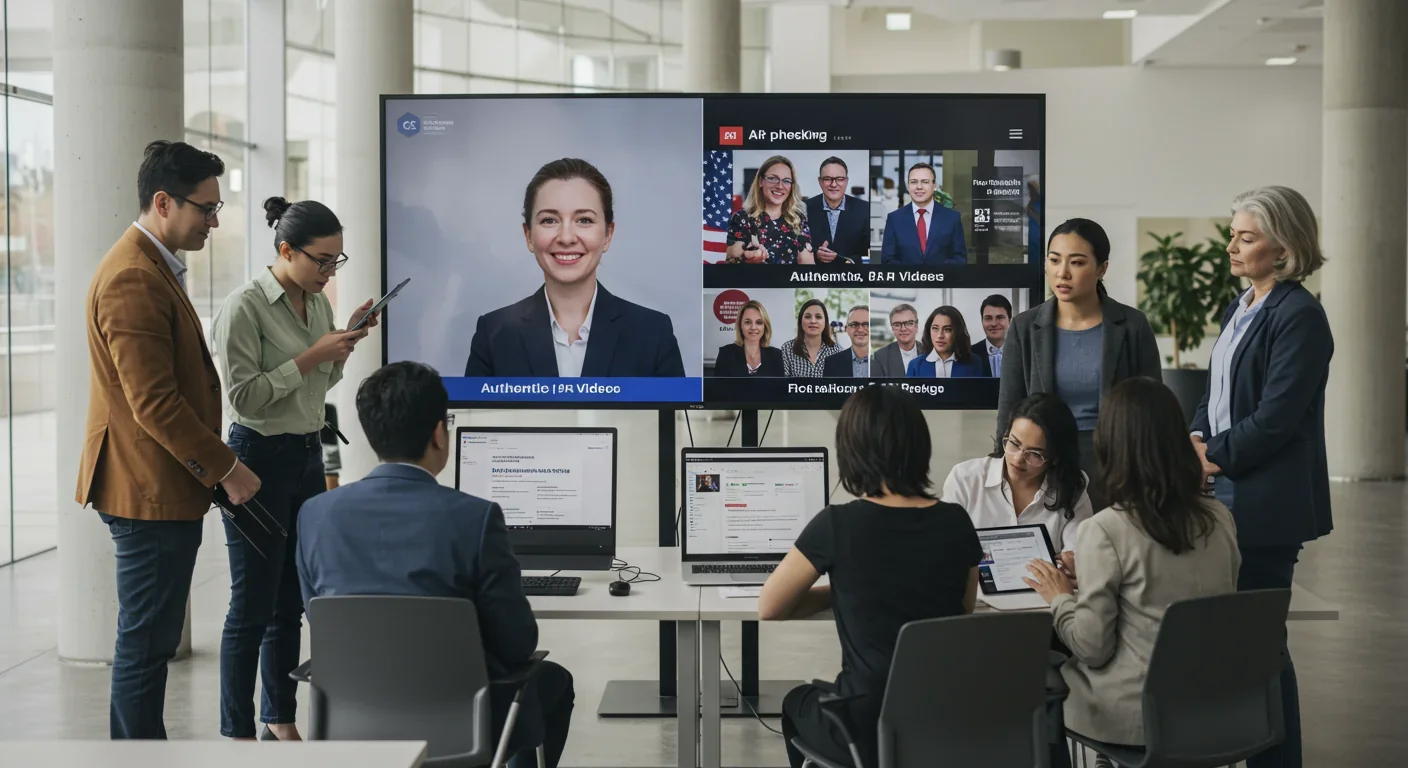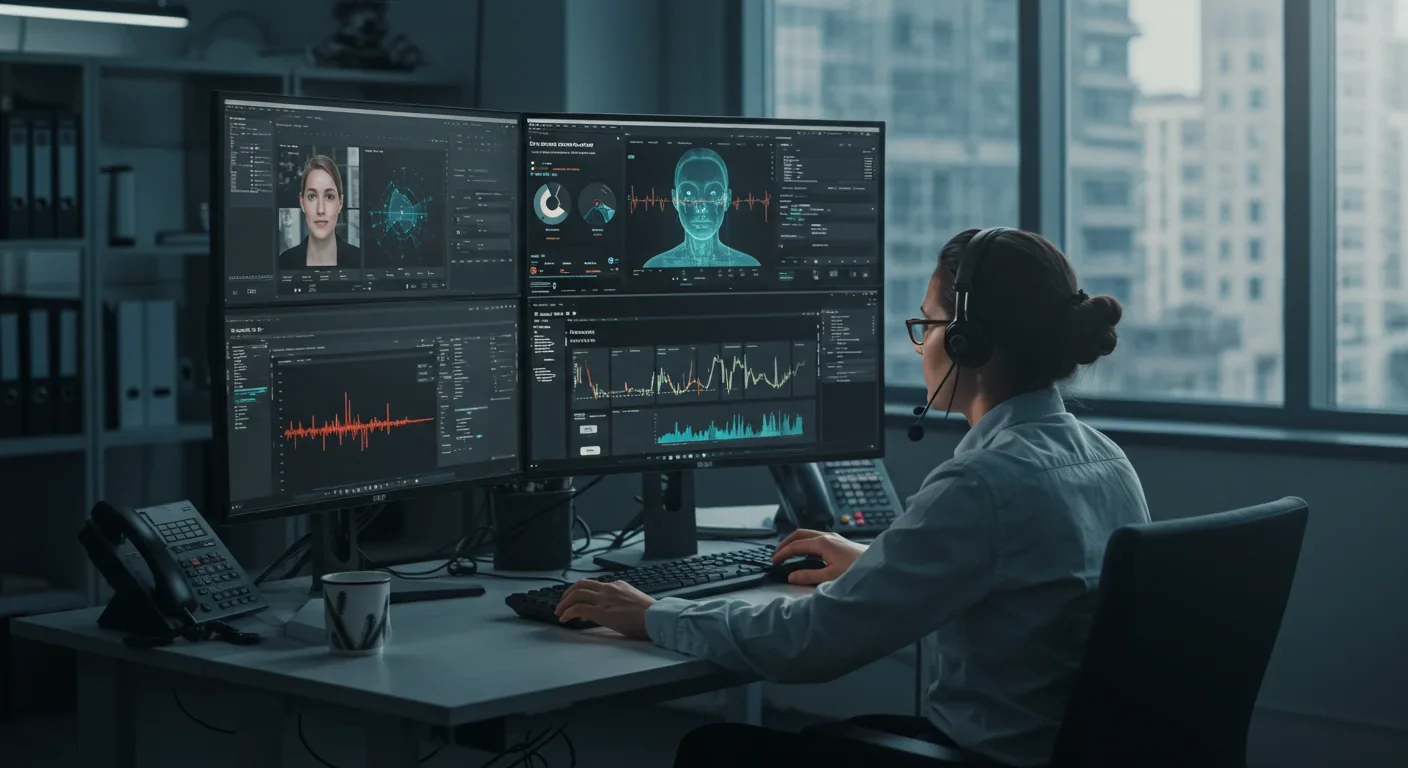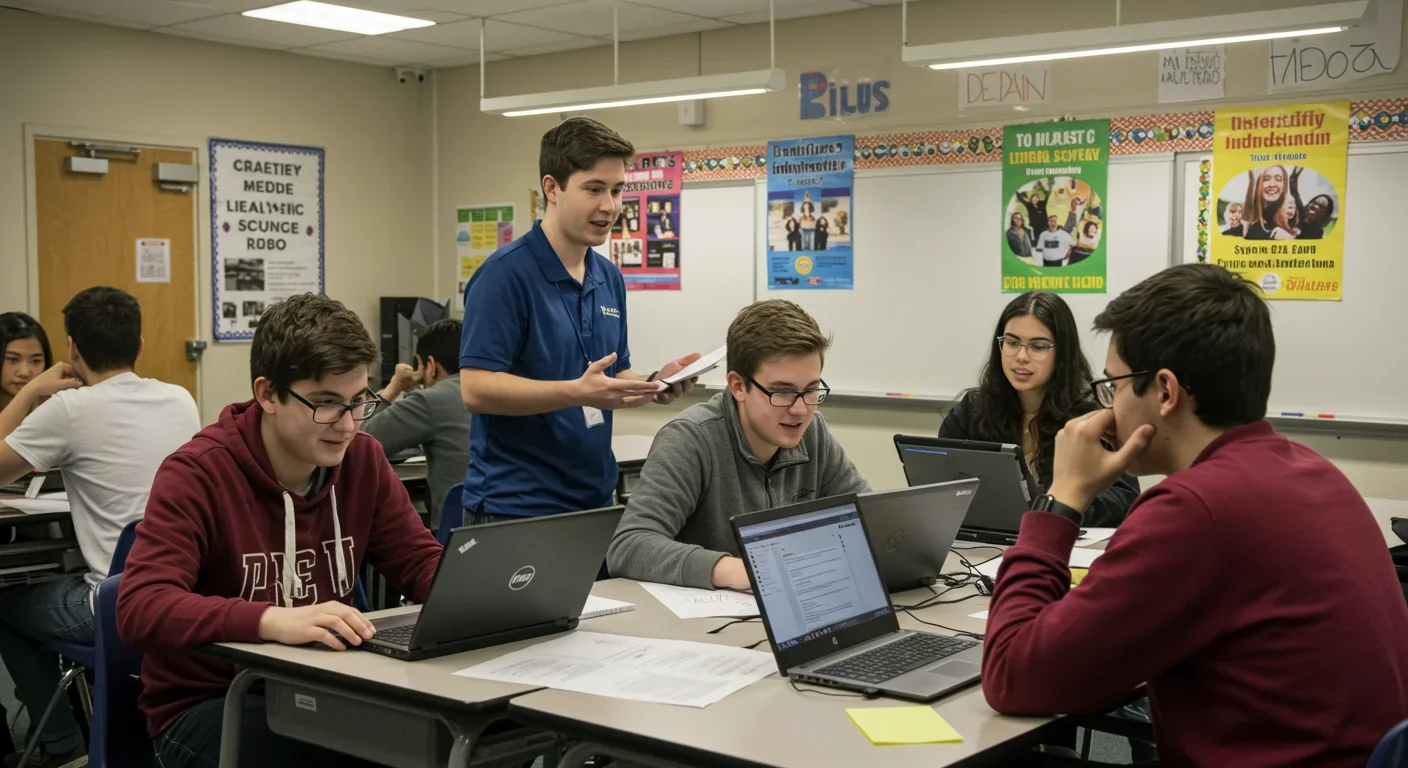Care Worker Crisis: Low Pay & Burnout Threaten Healthcare

TL;DR: AI-powered deepfakes are undermining democratic institutions by making reality contestable. While detection tools and legal frameworks struggle to keep pace, citizen media literacy and institutional resilience offer the most promising defenses.

By 2027, AI-driven fraud losses could hit $40 billion in the United States alone. But the most expensive casualty won't be measured in dollars—it'll be trust itself. We're witnessing the birth of a world where seeing is no longer believing, where authenticated video can be dismissed as fake, and where fabricated content can spark real-world chaos. Democracy, built on informed consent and verifiable truth, faces a challenge unlike any in human history.
In January 2024, a robocall mimicking President Joe Biden's voice urged New Hampshire voters to skip the primary. The cost to create it? One dollar. Time required? Less than 20 minutes. This wasn't some sophisticated state-sponsored operation—just a demonstration of how absurdly accessible deepfake technology has become.
The same year brought a cascade of incidents across the globe. In France, deepfake videos circulated before legislative elections, one fabricating details about Marine Le Pen's family life, another altering a France24 broadcast to claim Ukraine plotted to assassinate President Macron. In Ghana's general election, investigators uncovered a network of 171 fake accounts generated with ChatGPT, pumping out propaganda and smearing opposition leaders. These weren't isolated glitches in the system—they were coordinated influence campaigns exploiting AI's unprecedented scalability.
Perhaps most telling: 77% of American voters encountered AI deepfake content related to political candidates during the 2024 election cycle. We've crossed a threshold. Deepfakes aren't coming for democracy—they're already here.
Just ten years ago, creating convincing fake video required Hollywood-level resources. Today, generative adversarial networks (GANs) and diffusion models have democratized deception. These AI systems pit two neural networks against each other—one generating fake content, the other trying to detect it—in a competitive loop that produces increasingly realistic results. The generator learns to mimic subtle facial movements, voice inflections, even the grain and compression artifacts of authentic video.
The technical barriers have collapsed. You don't need coding skills or expensive equipment. Consumer apps can swap faces in real time, clone voices from seconds of audio, and animate still photos into speaking likenesses. What once required specialized knowledge now demands little more than a smartphone and malicious intent.
This shift represents more than technological progress. It fundamentally alters the cost structure of influence operations. Instead of hiring content professionals, bad actors deploy AI to produce political memes, doctored videos, and synthetic personas instantaneously at near-zero marginal cost. Scale that was previously impossible becomes routine.
The psychological damage extends beyond any single fake video. Researchers have identified what they call the "liar's dividend"—the ability for anyone caught on camera to dismiss authentic evidence as probable deepfakes. This creates a double bind: neither belief nor disbelief in recorded evidence can be fully justified.
Consider the implications. A whistleblower releases genuine footage of corruption. Officials dismiss it as AI fabrication. The public, having seen countless convincing fakes, doesn't know what to believe. Meanwhile, actual deepfakes spread, and viewers who've been burned before assume they're real. We're not just fighting misinformation; we're watching the erosion of shared reality itself.
Studies show this isn't theoretical. Research across eight countries found that social media news consumption amplifies the "illusory truth effect"—the tendency to believe information simply because you've encountered it repeatedly. Deepfakes exploit this cognitive vulnerability perfectly. A fabricated video, shared widely, starts to feel true through sheer exposure.
The financial sector offers a preview of what's coming. In January 2024, fraudsters using deepfake technology impersonated a company's CFO on a video call, tricking an employee into transferring $25 million. A 2024 survey found that 46% of fraud experts encountered synthetic identity fraud, 37% voice deepfakes, and 29% video deepfakes. If institutions designed for security can be fooled this easily, what hope do casual voters have?
The good news: detection technology is advancing. Researchers employ multiple methods simultaneously—metadata forensic analysis, pixel-level anomaly detection, audio-visual desynchronization tests, analysis of GAN fingerprints. Tools can spot inconsistencies invisible to the human eye: unnatural blinking patterns, subtle lighting mismatches, compression artifacts that don't match the supposed recording device.
The bad news: no detection system achieves 100% accuracy. Deepfake generators evolve specifically to defeat detection algorithms. It's a classic adversarial loop—each improvement in detection drives improvements in generation. Some experts warn that we may be approaching a point where synthetic content becomes indistinguishable from authentic recordings, even under forensic scrutiny.
Cross-channel coordination makes detection harder still. Modern influence campaigns don't rely on a single video. They build credibility through coordinated touchpoints across email, social media, voice calls, and text messages. Traditional detection systems fail because they analyze channels in isolation, missing patterns that only emerge when viewing the full campaign.

Adding to the challenge: detection tools require specialized expertise. Investigators must understand not just current deepfake techniques, but emerging approaches like diffusion-model fakes and live synthetic video calls. They need to track research from institutions like NIST and DARPA, validate tools against benchmark datasets, and maintain rigorous chain-of-custody protocols. Few news organizations or election offices have these capabilities.
Lawmakers worldwide are scrambling to respond, but legal frameworks lag significantly behind technological capabilities. Different jurisdictions have adopted wildly different approaches, creating a fragmented regulatory landscape that deepfakes easily exploit.
The European Union took the most comprehensive swing. The AI Act, operative since April 2024, establishes risk-based rules for AI systems, including specific provisions for deepfakes in political advertising. It requires transparency about synthetic content and imposes penalties for violations. Whether enforcement can keep pace with innovation remains to be seen.
In the United States, progress is piecemeal. At the federal level, the REAL Political Advertisements Act has been proposed to regulate generative AI in campaign materials, but hasn't passed. States are moving faster. California's AI Transparency Act (Senate Bill 942) requires platforms with over one million users to disclose AI-generated content and provide detection tools. Other states have enacted targeted laws around election-related deepfakes, creating a patchwork of regional regulations.
China, India, and other major democracies have introduced their own frameworks, but international coordination remains minimal. Deepfakes cross borders instantly; laws don't. This jurisdictional fragmentation enables bad actors to operate from friendly territories, beyond the reach of nations trying to protect their electoral integrity.
Critics argue that existing legal tools—defamation law, election fraud statutes, consumer protection regulations—could address deepfakes without new legislation. The FTC has taken enforcement action against companies that deceived consumers through AI. But applying analog-era laws to synthetic media creates gaps, particularly around speed of response and burden of proof.
If detection alone can't save us, and laws arrive too late, what can democracies do? The answer lies in systemic resilience rather than silver-bullet solutions.
Media literacy emerges as critical infrastructure. Finland's experience combating Russian disinformation offers a model. The country integrated critical media consumption into education at all levels, teaching citizens to question sources, verify claims, and recognize manipulation techniques. This population-level immunity proved more effective than trying to block every piece of misinformation at the border.
Similar programs need to address deepfakes specifically. People must learn that compelling video isn't proof, that emotional appeals often signal manipulation, and that verification before sharing matters. Schools, libraries, and community organizations can train citizens in digital hygiene the way public health campaigns taught hand-washing.
Authentication infrastructure needs to scale. The Coalition for Content Provenance and Authenticity (C2PA) has developed standards for embedding cryptographic metadata into media at creation. Cameras and recording devices can sign their output, creating a verifiable chain of custody. News organizations, election officials, and social platforms could prioritize authenticated content while flagging material that lacks provenance.
This isn't foolproof—authentication can be stripped, legitimate content might lack proper credentials, and bad actors can steal credentials. But it raises the bar. Instead of every piece of content being equally questionable, we establish gradations of trustworthiness.
Platform accountability must increase. Social media companies have the technical capability to detect and label synthetic content at scale. Some have implemented policies requiring disclosure of AI-generated political ads. Enforcement is inconsistent, though, and platforms face conflicting pressures—to protect free expression while preventing manipulation, to moderate content without being accused of bias.
Regulatory pressure is mounting. Transparency requirements force platforms to disclose how they handle synthetic content. Liability reforms might hold them accountable for failing to label known deepfakes. The key is creating incentives that align platform business models with democratic health.
Cross-channel intelligence platforms represent the frontier of institutional defense. Rather than treating email, voice, video, and social media as separate systems, organizations need unified intelligence that correlates signals across channels. When a deepfake video emerges, it's often preceded by coordinated messaging across other platforms. Detecting these patterns requires breaking down information silos.
Election officials in particular need this capability. Imagine an operations center that monitors not just social media chatter but suspicious robocalls, coordinated bot networks, and sudden spikes in synthetic content related to candidates or voting procedures. Early warning systems could trigger rapid response—fact-checking teams, voter education campaigns, even legal action.
Like many technologies, deepfakes are creating new inequalities. Sophisticated actors—state intelligence agencies, well-funded campaigns, organized criminal networks—have access to cutting-edge tools and expertise. They can create convincing fakes, distribute them through established networks, and obscure their origins.
Defenders, particularly in developing democracies, lack resources for advanced detection, legal frameworks to deter attacks, or media infrastructure to correct falsehoods quickly. The 2023 Nigerian presidential election saw AI-manipulated content spread rapidly, with limited capability to counter it.
This asymmetry matters. Deepfakes could entrench power imbalances, allowing resource-rich actors to dominate information environments while smaller players struggle to verify basic facts. International cooperation on detection tools, shared threat intelligence, and capacity building becomes essential.
At the same time, we're seeing grassroots innovation. Open-source detection tools, community fact-checking networks, and local media literacy programs emerge where institutions fail. The question is whether distributed defenses can scale fast enough to counter industrialized disinformation.

We're still in the early chapters of this story. Deepfake technology will continue improving—more realistic, easier to create, harder to detect. Defensive measures will advance too, but probably not fast enough to prevent significant damage.
The 2024 election cycle offered a glimpse of our immediate future: widespread exposure to synthetic political content, confusion about what's real, exploitation of ambiguity by bad actors, and institutions struggling to respond. It wasn't an apocalypse, but it was a warning.
What happens next depends on choices we make now. Do we treat deepfakes as a technical problem requiring better algorithms, or a societal challenge demanding comprehensive reform? Do we rely on platforms and governments to protect us, or build citizen resilience from the ground up? Do we pursue international coordination, or accept fragmented responses?
History suggests that transformative technologies rarely arrive with instruction manuals. We figure out governance through trial, error, and sometimes crisis. The printing press, telegraph, radio, television, and internet all disrupted information ecosystems before societies developed norms and regulations to manage them.
Deepfakes compress that timeline. We don't have decades to adapt—election cycles measure in months, viral content in hours. The infrastructure we build in the next few years will shape whether democracies can function in an environment where reality itself becomes contested.
Individual actions matter more than you might think. Before sharing political content, especially videos that provoke strong emotions, pause. Ask: Who created this? What's the source? Can I verify this through multiple independent outlets? Does this feel designed to make me angry or afraid?
Support news organizations that invest in verification. Many have established fact-checking teams specifically focused on synthetic media. Subscribe to, share, and amplify their work. Quality journalism is expensive; defending truth even more so.
Demand that platforms you use take deepfakes seriously. Push for clear labeling of synthetic content, transparency about moderation policies, and accountability when fake content spreads unchecked. User pressure has driven platform policy changes before.
Advocate for education reform that treats media literacy as essential, not optional. Digital discernment isn't a specialized skill—it's basic citizenship in the 21st century. Schools should teach it alongside reading and math.
Finally, stay informed about emerging threats. The deepfake landscape evolves constantly. Tools that work today might fail tomorrow. Communities that discuss and share knowledge about synthetic media build collective resilience.
The stakes couldn't be higher. Democracy requires that citizens make informed decisions based on shared reality. Deepfakes attack that foundation, not by preventing access to information, but by making all information suspect. In the resulting fog, authoritarians thrive.
But technology isn't destiny. Societies that recognize the threat, invest in defenses, and cultivate informed skepticism can navigate this transition. The alternative—a world where truth is whatever the most convincing AI says it is—represents a civilizational failure we cannot afford.
The deepfake era has arrived. What we do with that reality will determine whether democracy survives it.

Recent breakthroughs in fusion technology—including 351,000-gauss magnetic fields, AI-driven plasma diagnostics, and net energy gain at the National Ignition Facility—are transforming fusion propulsion from science fiction to engineering frontier. Scientists now have a realistic pathway to accelerate spacecraft to 10% of light speed, enabling a 43-year journey to Alpha Centauri. While challenges remain in miniaturization, neutron management, and sustained operation, the physics barriers have ...

Epigenetic clocks measure DNA methylation patterns to calculate biological age, which predicts disease risk up to 30 years before symptoms appear. Landmark studies show that accelerated epigenetic aging forecasts cardiovascular disease, diabetes, and neurodegeneration with remarkable accuracy. Lifestyle interventions—Mediterranean diet, structured exercise, quality sleep, stress management—can measurably reverse biological aging, reducing epigenetic age by 1-2 years within months. Commercial ...

Data centers consumed 415 terawatt-hours of electricity in 2024 and will nearly double that by 2030, driven by AI's insatiable energy appetite. Despite tech giants' renewable pledges, actual emissions are up to 662% higher than reported due to accounting loopholes. A digital pollution tax—similar to Europe's carbon border tariff—could finally force the industry to invest in efficiency technologies like liquid cooling, waste heat recovery, and time-matched renewable power, transforming volunta...

Humans are hardwired to see invisible agents—gods, ghosts, conspiracies—thanks to the Hyperactive Agency Detection Device (HADD), an evolutionary survival mechanism that favored false alarms over fatal misses. This cognitive bias, rooted in brain regions like the temporoparietal junction and medial prefrontal cortex, generates religious beliefs, animistic worldviews, and conspiracy theories across all cultures. Understanding HADD doesn't eliminate belief, but it helps us recognize when our pa...

The bombardier beetle has perfected a chemical defense system that human engineers are still trying to replicate: a two-chamber micro-combustion engine that mixes hydroquinone and hydrogen peroxide to create explosive 100°C sprays at up to 500 pulses per second, aimed with 270-degree precision. This tiny insect's biochemical marvel is inspiring revolutionary technologies in aerospace propulsion, pharmaceutical delivery, and fire suppression. By 2030, beetle-inspired systems could position sat...

The U.S. faces a catastrophic care worker shortage driven by poverty-level wages, overwhelming burnout, and systemic undervaluation. With 99% of nursing homes hiring and 9.7 million openings projected by 2034, the crisis threatens patient safety, family stability, and economic productivity. Evidence-based solutions—wage reforms, streamlined training, technology integration, and policy enforcement—exist and work, but require sustained political will and cultural recognition that caregiving is ...

Every major AI model was trained on copyrighted text scraped without permission, triggering billion-dollar lawsuits and forcing a reckoning between innovation and creator rights. The future depends on finding balance between transformative AI development and fair compensation for the people whose work fuels it.